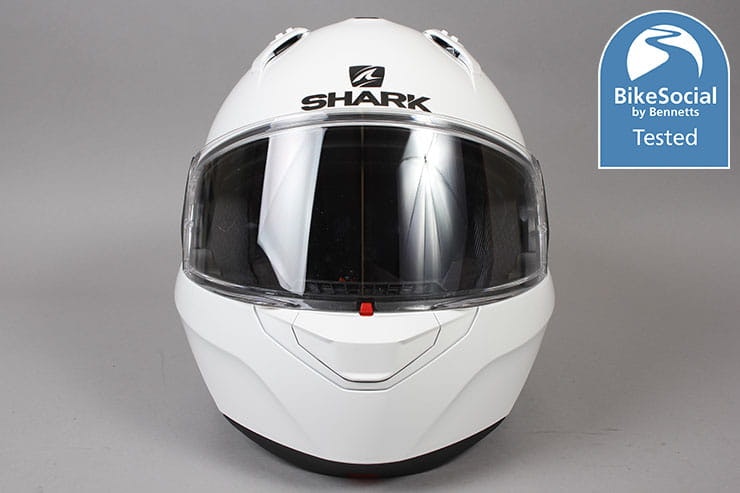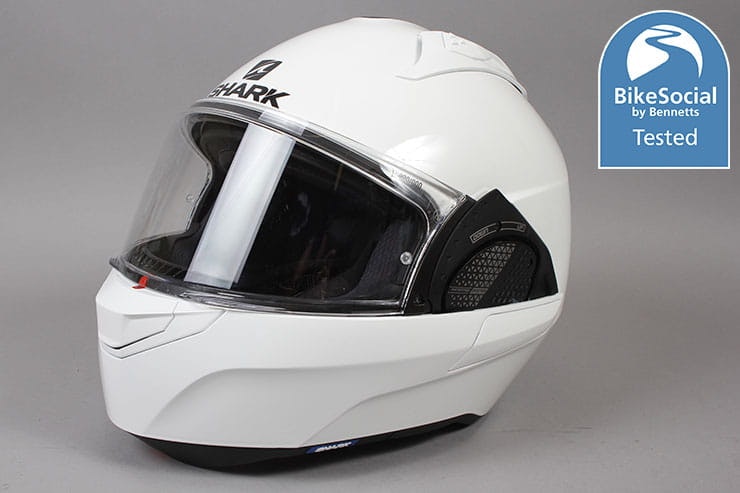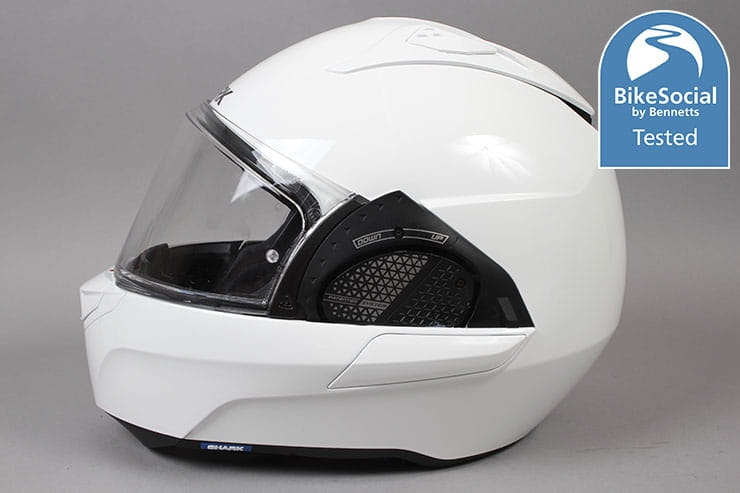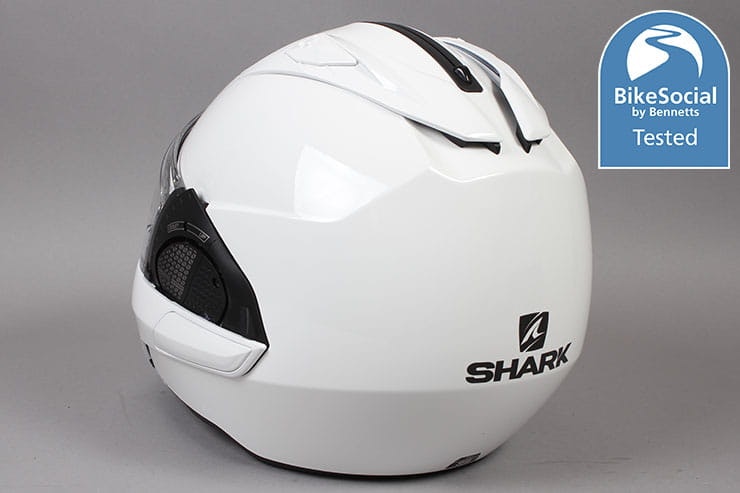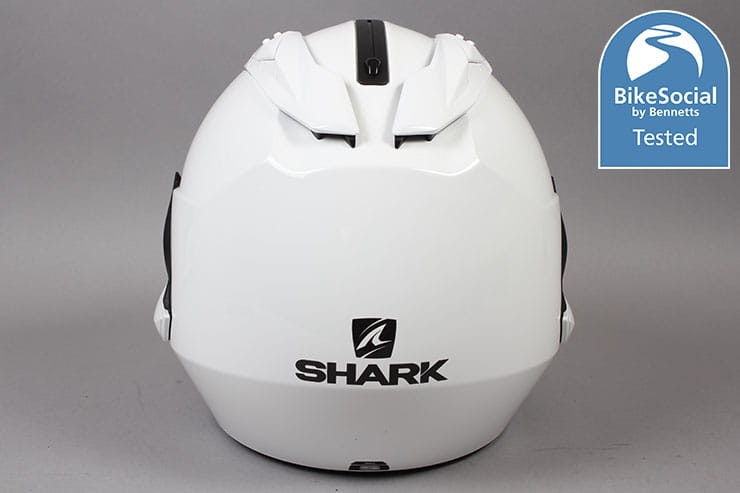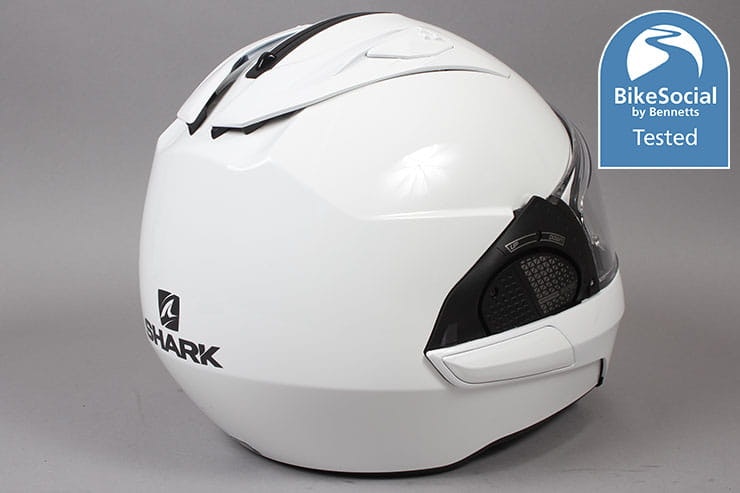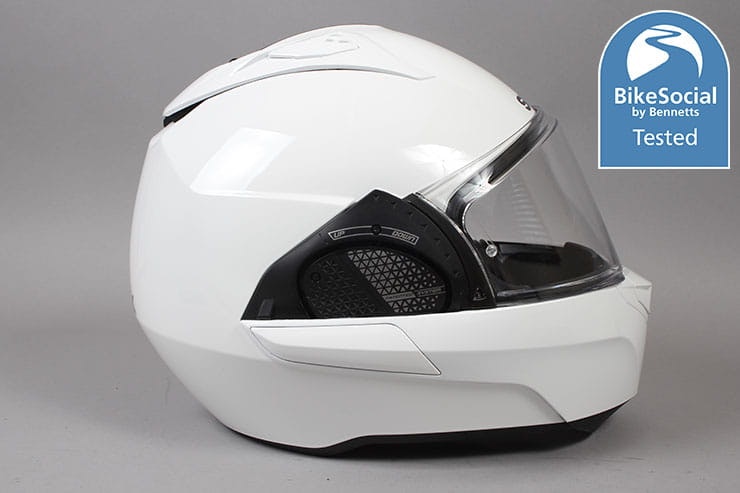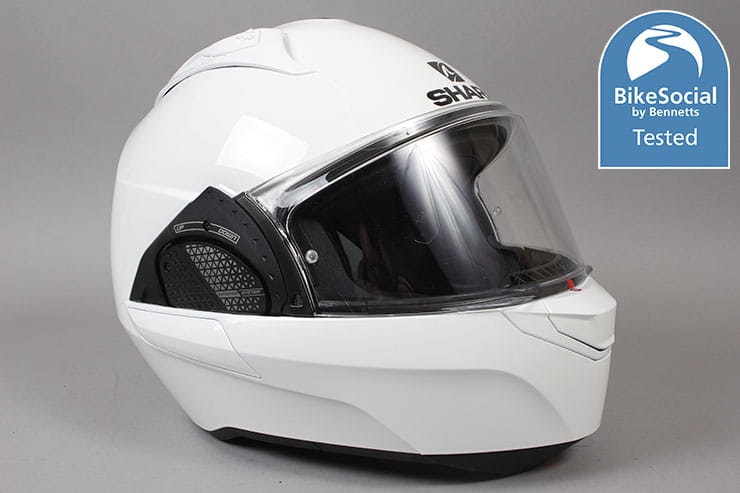Tested: Shark Evo GT helmet review
By BikeSocial Member
Everyday riders, just like you...
27.05.2021
Date reviewed: May 2021 | Tested by: Graham Mudd, BikeSocial member | RRP: From £369.99 | www.nevis.uk.com
I’ve had the Shark Evo GT on review here for a month now and have covered around 1,500 miles in that time; I work 50 miles from home and come rain or shine I commute on my Zero DSR and Kawasaki Versys 650 workhorses. It’s a real mix of rural, fast single carriageway, dual carriageway and urban roads, so a proper test of any kit I’m riding in. I also enjoy pottering along single-track country roads with grass growing down the middle, and some gentle byways.
The weather was unseasonably good for April where it was largely sunny with some frosty mornings but warm in the afternoons. This last week in May has seen some torrential downpours, roll on summer! I’m lucky that I’ve been given the LS2 Valiant 2 to test too, so can compare them as they’re of similar spec in the same price bracket…
Good ventilation
Cosy in winter
Seal on visor aperture is much improved
Chin bar mechanism can jam
Chin bar doesn’t always lock reliably
Clumsy visor release
Outer shell
Shark constructs the ECE 22.05 Evo GT in two shell sizes – a smaller shell for XS/S/M and a larger one for L/XL/KS (King size). I have the plain white model, which costs £369.99, though graphics are available for an additional £20.
The Shark’s homologated for use as both an open face and full face helmet, though if you’re thinking of doing track days you may need to look elsewhere as it isn’t approved by the ACU for racing. I was a little surprised that Shark had opted for a thermoplastic shell – often seen in more budget helmets – as other modular helmets in this price bracket, such as the still-available Schuberth C3 Pro are made of a fibreglass construction. This isn’t a bad thing as such – both perform well in testing – but I’ve just always felt it’s more of a premium construction method.
The GT has a more classic and clean shape than previous Evos, which I like, doing away with the wings and aerofoils that are en-vogue at the moment.
The chinbar mechanism was pioneered by Shark with the original Evoline way back in 2008 and has improved gradually over the years; as opposed to most flip-front helmets, where the whole face lifts to around horizontal, in the Evo series the chin-bar rotates on an eccentric pivot all the way to the rear of the lid. This makes it more like an open-face and eliminates the sail effect you get when riding with a conventional flip-front open.
The mechanism is easily operated even with winter gloves via a button under the chin – simply press and lift and the chin bar rotates smoothly all the way to the back. Unfortunately the Evo GT suffers the same issues as the Shark Evo ES I previously tested – once to the rear it sometimes jams in that position and needs a fair old whack to get it moving. I can only imagine what I look like to cars behind me as I seemingly try to karate chop myself in the back of the head!
Occasionally I’ve had the mechanism jam on the visor while opening too, which was a bit disconcerting as it partially obscured my vision while riding. Finally, on closing, the locking mechanism often doesn’t engage properly: if you pull up, the chin bar lifts again which would be dangerous if you didn’t realise and were in an accident. To lock it firmly you need to cinch it closed with thumb and fingers until you hear an audible click.
I’ve spoken to a few Evo owners and these seem to be common problems, which is a real shame as it has the potential to be great product. I’ve always held Shark in high regards and never had any of these problems with my now obsolete Evoline 3… d efinitely something for Shark to work on. In comparison, the LS2 Valiant 2 I’ve tested is highly refined, operating smoothly every time and clicking locked with no effort.
Weight
My small weighed in at 1,670g; most helmets of this type are quite heavy as the chin bar mechanism adds a fair bit of weight but that being said I’ve been on full day rides and the weight hasn’t made my neck tired or sore.
Other helmets I’ve ridden in have suffered quite badly with buffeting, especially on my Zero with its rubbish screen, but the Shark fares well in smoothing out the air and reducing the battering my head takes from the wind! Marginally lighter than its LS2 rival, but over 100g heavier than the Schuberth C3, I wouldn’t worry too much about the weight of most lids.
Ventilation
Here the GT fares pretty well with a large vent on the chin and two large scoops on the top.
With all vents open there’s a significant draught through the helmet and with all vents closed merely the barest hint of cold air wafting across your face; being bald I can feel the cool air from the top vents flowing over the top and down the back of my head, despite the only exhausts being towards the top of the rear of the shell.
The vent covers are large, and in the case of the top vents studded, easily operated with winter gloves on and open with a reassuring clunk so you know they’ve opened and closed. I was particularly impressed with the chin vent, which opens outwards from the top. Unconventional, but it means it seals better from cold wind and stops cold air chilling your face in winter, something the LS2 Valiant suffered quite badly with. In addition to this there’s an internal switch in front of your mouth that can select air to be directed to your face or up across the visor to aid in demisting. It takes a bit of practice with your thumb with the visor open, but once you’ve got the knack it’s second nature. I thought it was a nice feature to be able to select where the air entering the helmet is directed.
There’s a fabric skirt built into the chin-bar to eliminate draughts entering the helmet via the neck. While not in use it’s tucked away, held in place with magnets. While this is a neat idea, it doesn’t work too well in practice. There’s a large but thin plastic loop you need to hook your finger through to pull it down, which is not easy when you’re wearing winter gloves with a Visorcat and can’t see or feel where the loop is. I had to raise the chinbar slightly so I could see where the loop was, which is not safe on the move as it partially obscures your vision. When in place the chin skirt does a good job of keeping out the cold and even in wintry conditions the inside of the Shark Evo GT is a cosy place to be.
Visor
The visor is pleasingly thick and robust feeling. A top-of-the-range Pinlock Maxvision 120 is included in the box, which deals with any misting problems once you’ve popped it in. Even with frost on the ground and a nip in the air, breathing heavily only produced the smallest fog patch at the bottom of the visor, which cleared as soon as I resumed breathing normally.
Shark claims that the visor meets Class 1 optical standard, which means there’s zero distortion viewing through the curved surface, but I have found this not to be the case. It’s only very slight, but there’s a small amount of distortion, and because it’s slap-bang in the centre of my field of vision it was quite distracting at first. I removed the Pinlock insert to make sure it wasn’t that and confirmed it was the visor. I’m used to it now and barely notice.
The field of view is excellent and I’m barely aware of the helmet entering my peripheral vision.
The visor removal technique leaves something to be desired. It’s held in place by a tab, but you need a ballpoint pen (or something else thin and pointy) to press the tab in and slide the visor out of its mount. It’s simple, with no covers or plates or things to line up or tighten, but it still means carrying a pen. And I had to exert quite a bit of force to get the tab to ‘pop’, to the point I was worrying about breaking the mount. It will probably ease off with time, but neither my Evoline 3 nor the Evo ES I tested last year needed that amount of effort to get the visor off. At least remounting the visor is a simple case of clicking it back in.
Riding through light showers the seal on the visor was solid, however riding through sustained heavy rain a couple of drips did make their way down the inside. A marked improvement on my Evoline 3, where I sometimes considered applying RainX to the inside of the visor as well as the outside, the seal was that poor! A common problem with modular helmets is a draught across your face, something the Evo GT also manages to cut to a minimum.
The drop-down sun visor is excellent. The darker than average shade makes riding early in the morning and in the evening with the sun low in the sky a comfortable experience. The LS2 Valiant (and most other helmets I’ve had) have a lighter shade that leave you squinting in the brightness, to the point I’ve felt the need to apply a couple of lines of PVC Electrical tape to the top of the visor so I can drop my head slightly and block out the sun. Something I remember my dad doing in the 1980s! The sun shield is operated via a switch on the crown, which is easy to find and use with winter gloves on.
Lining
Probably the best bit about the Evo GT, the lining is plush and feels luxuriantly soft against my wonky bald head. I’ve worn the helmet all day on two 250 mile trips and on both occasions was as comfy at the end as at the start. At first it was a little too much on the snug side, but over the course of a week it bedded in nicely.
The lining cups under your jaw making it feel reassuringly secure, and also cuts out any draught trying to sneak up past your neck into the helmet. The Shark comes with two sizes of cheek piece included, I opted for the thinner 25mm size as with the chin bar closed I found the 30mm ones gave me ‘hamster cheeks’.
Two pairs of cheek pads are supplied to find the best fit, plus a set of reflective stickers (a legal requirement in France)
Easy to remove for washing, the lining is mercifully simple to reinstall into the helmet. I found the LS2’s liner was unnecessarily fiddly and frustrating to put back in (as were many other helmets I’ve had over the years) but the Evo GT slipped back in easily and everything lined up and snapped into place on the first attempt.
The cut-outs for a headset are well placed and deep enough to hold my Maxtek earpieces without them pressing on my ears. It’s a problem I’ve had with other helmets (including the LS2) where the indents are too shallow meaning the headset pinches your ear lobe slightly – comfy enough for short rides but uncomfortable after a couple of hours. This is certainly not a problem for the Shark and with earplugs in I could listen to my tunes all day without complaint.
Fastening
Fastening is done with a Type 2 micrometric buckle, meaning the whole mechanism is made of metal (not plastic) for extra safety. I love them for their ease of use and simplicity; simply push the ratchet in to the desired number of clicks, then pull down on the tab to release. It’s even easy to use with winter gloves on.
There are often debates on forums about this type of buckle, but the simple fact is I’ve always hated double-D rings as they’re awkward, and impossible with numb hands in winter. I’d point out that there are plenty of high-end helmets (rated five stars on the SHARP website) with micrometric buckles and if you break your neck or the strap decapitates you, double-Ds apparently being safer is purely academic.
Fit
It’s important to try any helmet on before you buy. Everyone’s head is a different shape and some manufacturers will fit better than others – BikeSocial’s consumer editor, John, finds that half of the Shark range works for him but the other doesn’t.
My dad swears by HJC and Shoei, my brother Bell and AGV. For me Shark is one of the brands that fits me best though I’m not saying you have to have a head shaped like Kryten from Red Dwarf to find it comfortable. In (relatively) warm weather, cold, long trips or short blasts the Evo GT has been flawless in its comfort. The lining I’ve covered above, but the multi-layer EPS foam causes no pinch points or sore spots anywhere on my scalp. Often I find after a couple of hours I’m grateful to remove a helmet for a bit while my prematurely achey joints take a break, but the Shark I was happy to wear all day. Top marks for fit and comfort.
I don’t need specs, but I put on a pair of sunglasses and they were fine for several longer rides. My ears never felt pinched between the lining and the glasses’ arms.
The pull-down skirt does a good job but can be a bit of a fiddle to reach
Noise
Every single modular helmet I’ve worn – including the Schuberth C3 – has been noisier than the equivalent full-face helmet. The shell being slightly bigger, the added external mechanism that allows it to pivot, the joints in the chin bar – they all conspire to make for a louder than average helmet.
As someone who suffers with permanent tinnitus (not just from riding bikes) I always recommend you wear ear plugs when riding outside of 20 and 30mph zones, however with the Shark Evo GT (as with the LS2 Valiant 2) it is a necessity at anything more than 40mph. That being said, in balance, it’s significantly quieter than the Caberg and Givi X01 I used to own. I think if you’re in the market for a modular helmet, noise is a compromise you have to be willing to make, and the convenience of having both a full face and open face helmet in one compensates this.
For more information on why earplugs are vital with any helmet, and advice on which are the best, click here.
The Shark Evo GT is a solid performing helmet with a swath of nice points and great design features. Super comfy to wear all day with vents that will keep you cool in warm weather it certainly lives up to the GT moniker.
While I love the flexibility the Evo range gives you – open face for summer (and petrol stations post-Covid), full face for winter and ‘jet’ for everything in between, I feel a bit let down that the chin-bar mechanism is flawed. To have the chin-bar jam in the rear position is annoying, but to have it jam halfway open against the visor while riding and not easily lock properly closed is dangerous. I feel doubly let down because Shark practically invented this style of helmet, and I loved my Evoline 3, which had none of these problems.
Chin-bar issue aside, I like the Evo GT. I do! If Shark fixes these issues in the next iteration, it will doubtless have one of the best touring helmets on the market, but I don’t feel I can recommend it with the faults in place. As it is, I feel the LS2 Valiant 2 is the better helmet, and at £100 cheaper it’s an absolute bargain.
